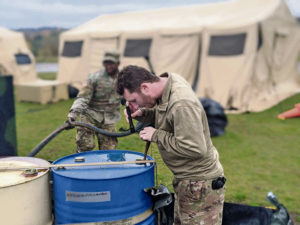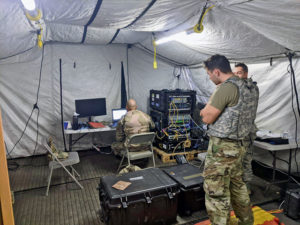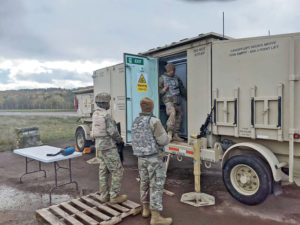
Airmen assigned to the 1st Combat Communications Squadron held a combat readiness course to validate their ability to defend themselves and their equipment in hostile environments.
The squadron tested capabilities to include site defense, tactical driving, nighttime operations and local relations. These competencies enable the 1st CBCS to successfully support U.S. and allied warfighters in any environment.
“The 1st CBCS is the only tactical communications unit in the European and African theaters,” said Master Sgt. Bret Zamzow, 1st CBCS expeditionary training section chief. “Without the capabilities provided by the 1st CBCS the Air Force would not be able to set up forward locations anywhere in the two continents, which would prevent the ability to deter aggression; nor would we be able to counter violent extremist organization support in Africa.”
The 1st CBCS, which is a part of the 435th Air Ground Operations Wing, focused this exercise on improving their communications capabilities. Communication is a pivotal resource to successful missions throughout the European and African theaters.
“The course focused on getting communications up in a contested environment,” said Tech. Sgt. Vicente Velazquez, 1st CBCS tactical cyber operations team lead. “Scenarios were given throughout the duration as building blocks and to see how the teams would perform.”

Exercise coordinators designed the training to include various scenarios that tested the Airmen’s many proficiencies, which aligns with the 435th AGOW’s mission to rapidly establish expeditionary airfield operations and communications and provide theater-wide combat support and training.
“Over the course of sixty days students learned a lot about protecting their site, how to interact with the local population, setting up a live communications system in a simulated deployment and how to work as a team to accomplish their objectives,” Zamzow said.
The 1st CBCS’ team mentality allows them to accomplish a lot within limited parameters.
“We are one of the rare units that can provide small and large communication support from a bare base and austere locations,” Velazquez said. “We utilize our own services when needed to support hundreds of customers.”
Airmen will continue to face new challenges in their respective domains. With these new challenges, the Air Force will develop new training plans to adapt and overcome them, and the 1st CBCS is no exception.

“It is through this type of training and these types of exercises that our personnel learn how to prepare for the next generation of adversaries,” Zamzow said. “We never know when the next conflict or war will happen, but the 1st CBCS will be ready to answer the call and provide forward operating communications in hostile environments due to the hard work of instructors and students coming together to change culture and develop the next wave of warfighters.”


